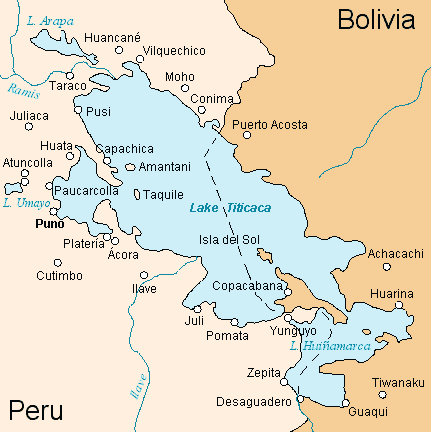The bus picked us up at our La Paz hotel at about 7:00am and took us to the Bolivian side of
Lake Titicaca. This is the largest lake in South America and often called the "largest navigable lake in the world." It is at an elevation of about 3,800m or about 12,000 ft. We had lunch here before boarding the bus again to the ferry terminal, where we crossed the lake on a ferry while the bus went on a separate ferry.
 |
| Bolivian side of the lake |
 |
| Boarding the ferry to go across the lake |
 |
| Another look at the Bolivian side |
 |
| Going through Immigration in Puno, Peru, after crossing the lake |
 |
| We are in Peru! |
It took us a couple of hours to go through Immigration, first for leaving Bolivia, then for entering Peru. When finished, we drove another couple of hours or so to the town of Puno.
We checked into the Munay Tambo Hotel in Puno. It is very centrally located, about 20m from a popular pedestrian mall that runs through the town. The night we arrived, there was a celebration for the end of Lent. There were parades and dances at the main plaza. Kids were spraying each other with foam. I enjoyed watching them do their native dances.
 |
| A dance troupe performing and marching down the mall |
 |
| A couple of smiling and happy dancers |
 |
| Dancing in the main square |
 |
| Kids spraying foam (shaving cream) at each other |
The next day we drove to Lake Titicaca. Our plan is to visit two places: Taquile Island and Uros Island. Both are very different even though the islanders have been living on this lake for generations.
 |
| Map of Lake Titicaca. By es:Usuario:Haylli, based on map from http://www.aquarius.geomar.de - http://www.aquarius.geomar.de/omc/, CC BY 2.5, https://commons.wikimedia.org/w/index.php?curid=31580 |
 |
| Sign about Lake Titicaca at the lake |
We first took about a 2-hour boat ride to Taquile Island. From the dock it is a very steep climb to the top of the island where the town square is located. This island depends solely on tourism for its economy. There are no cars and hotels on the island. No electricity also. On the day we were there, many tourists were there as well. All the men here learn how to weave at a young age. It is a skill that women consider when marrying a man. The islanders have a tight self-governing system, where crime and divorces are not tolerated. The island grows many crops but they are for their own consumption. On certain day of the month, vendors from the mainland come and sell them meat and produce. The islanders sell their handicrafts, especially woven souvenirs like hats, towels, etc., to tourists for their income.
 |
| A Welcome Sign but please pay your tax |
 |
| Town Square where the islanders come to sell their stuff |
 |
| A narrow alley between the buildings |
 |
| A beautiful mountain side |
 |
| Our guide Sylvia on the right. Man on the left is the restaurant owner |
 |
| Showing off his knitting skills |
 |
| A tasty trout lunch |
 |
| Steps to the restaurant |
 |
| Bathroom with a view of the ocean |
 |
| Walking through another part of the island |
 |
| Beautiful view of the farms and ocean |
On the way back to Puno we stopped at Uros Islands. It consists of many small islands built from reeds called
totora, a buoyant reed that grows abundantly in the shallows of Lake Titicaca. These islands float on the water and can be sub-divided when necessary. Situations like when the island gets too big or there are disputes between some of the residents, they can take a saw and cut off a portion of the island. They have been growing in numbers and now there are about 100 of them. Each island houses several families, usually part of an extended family. Solar panels provide electricity for the families. These islands have become one of Peru's tourist attractions.
 |
| Inside one of the family's "house" |
 |
| The base of the island is made from compressed reeds mixed with soil |
 |
| Riding in a reed boat, approaching the "shopping mall" |
 |
| A little girl who charmed the tourists |
 |
| A reed boat used for transporting residents and tourists |
This was an interesting visit to two islands that I knew nothing about and an important lake that I also have not heard of. They are very much of Peru's culture and history. I am glad I had the opportunity to experience this first-hand.
The next morning we take a public bus for a 7-hour journey through the highlands then the Altiplano from Puno to Cusco. In Cusco we'll begin our Machu Picchu adventure.



























No comments:
Post a Comment